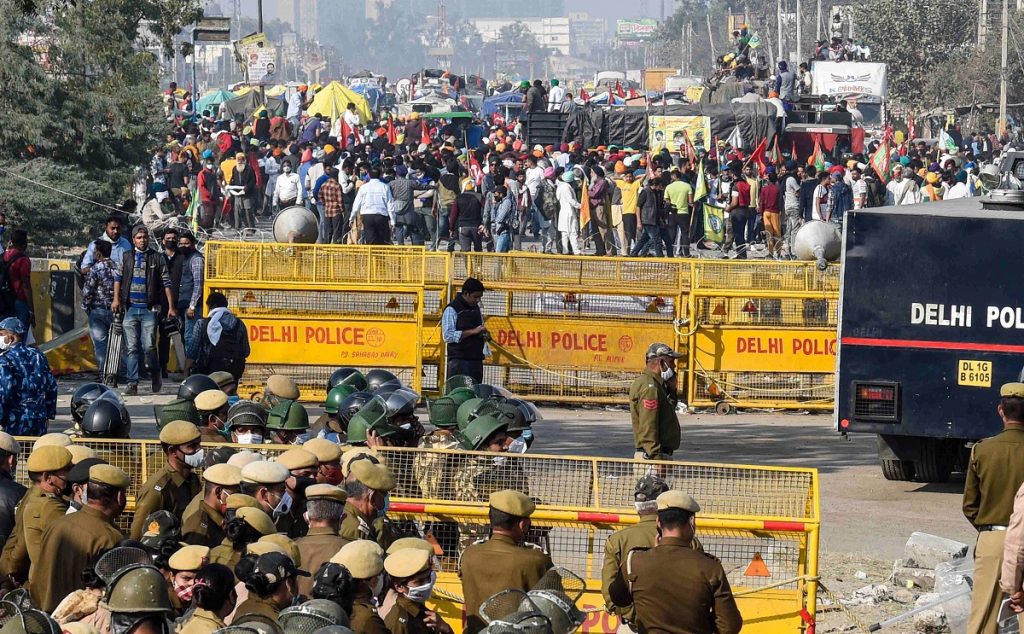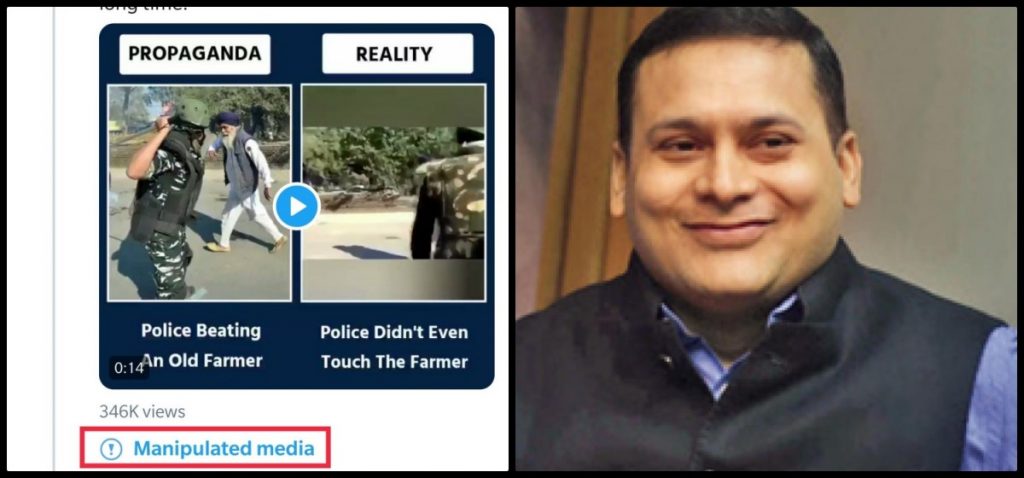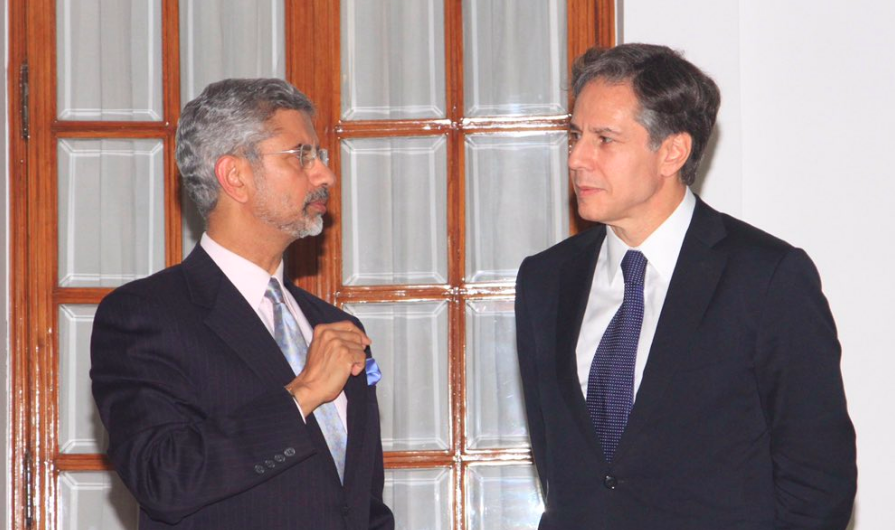Backstory: Farmers’ Protest and Callousness – as the Media Sows, So Will They Reap
There are moments in a country’s life to which its media are required to respond in a way that reflects their significance. The farmer protest that literally has the country’s capital city in its grip is surely one such.
Take its magnitude: the sea of humanity outside Delhi’s door is said to comprise over 2 million people agitating on an issue that touches the lives of at least 110 million (if you go by the number of farmers with landholdings two acres and less, who are said to be beneficiaries of the PM Kisan scheme) and their families.
Take its human dimensions: Farmers are by no means a homogeneous category – The Wire analysis, for instance, rightly cautions against ignoring the piteous condition of over 144 million landless workers and peasants who also come under the broad rubric of the term ‘farmers’. What is common though across the board is the experience of indebtedness. Studies have found that at least half the farming community in India is in debt and this is also one of the major reasons for why over 10,000 farmers take their own lives every year. The persistence of these deaths by suicide, which in themselves indicate a perverse, unacceptable reality, have now become so normalised that they lightly bounce off the news firmament. No need for trigger warnings here.
Take its history: The cry “karz mukti” (freedom from debt) has been raised by generations of farmers, only to fall on deaf ears by and large. Many of those protesting today are the children and grandchildren of stalwarts who have led similar protests against the might of the Indian state. For how long will a country with 60% of its population still linked to the land continue to ignore its real sons and daughters of the soil?
Take its passion: here are men and women braving the coldest season of the year – some have already succumbed to the harsh conditions (‘At Least Three Deaths Reported During Farmers' 'Delhi Chalo' Protest’, December 3) -- in order to find redress for the injustices done to their community. The railroading through parliament of the three farm laws that farmers fear “would throw all the marginal farmers, who incidentally are 85% of the total farming cohort, to the mercy of private players” (‘Three Farm Bills and India’s Rural Economy’, October 1) was like being put into a chakki (the mill) and ground down, as one farmer put it.

Police stand guard near a barricade as farmers protest at Singhu border during their 'Delhi Chalo' march against the Centre's farm reform laws, in New Delhi, November 29, 2020. Photo: PTI/Atul Yadav
Words of such poignancy cannot, of course, compete with the words of instruction passed down from the power corridors of Raisina Hill. Our most celebrated news anchors, suitably suited and booted, coiffeured and manicured, then resort to hurling calumnies against the agitators. Media observers like Newslaundry did a fine job documenting the coverage.
The template goes something like this: indignation boils over precisely at prime time over the lack of “faith” the protesters have on prime ministerial assurances. A modicum of independence may have allowed them to understand why this is the case (The Wire carried an important analysis on this, ‘Why Indian Farmers Find it Hard to Trust the Government's Promises’, December 4), but independence we know is not their strong suit. Along with this show of umbrage comes the attempt to undermine the protest by accusing it of having been fomented by the enemies of Narendra Modi, which in their lexicon amounts to being “anti-national”.
It’s amusing how the same terms of reference are now being used by channel after channel. For example, an amorphous, undefined term like “The Lobby” is bandied around in ways designed to raise the threat perception of the average viewer, and the hidden “Congress” hand inevitably haunts the narrative. All this sometimes segues into outright slander with hashtags like #AndolanmeinKhalistan making their way seamlessly across chat shows and social media posts. The Wire report, ‘Farmers' Protest: Despite Rightwing Propaganda, 'Khalistani' Angle Finds Little Traction’ (December 3), quoted an instance of a Chandigarh-based retired major, who supported farmers, being trolled with terms like ‘Khalistani,’ ‘madrassa chhap’, and ‘sickular’. When the Centre resorts to its usual tactics of intimidation by using the Enforcement Directorate and the CBI, these channels work quickly to amplify the impact. Finally, there is the deliberate withholding of coverage, as if to break the back of the movement by pretending it doesn’t exist.
But as the media sows, so will they reap. The farmer protestors now actively boycott what they term as the “godi media” (lapdog media), the expression popularised by Ravish Kumar that is well understood across the Hindi speaking states to mean newspapers and television channels that operate as extensions of the ruling party. Sometimes this can make things rough for the individual reporters representing these channels in the field, and there has been the recent unfortunate case of hot tea being allegedly flung at a reporter from Zee Punjabi. Which begs the question, if the sources of news actively begin to withhold their information from news channels they see as biased, would the reportage put out by these channels hold any credibility at all? Or have they arrived at a point where they are quite comfortable putting out complete fabrications from government sources, using their professional skills to dress up the information as news?
It wasn’t always like this. Delhiites continue to remember Mahendra Singh Tikait’s week-long siege of the capital in 1988 because the newspapers of the day took it seriously. To this day, those largely black and white photographs of the man and his hookah along, with images of the teeming masses of people he had led into the heart of the city, remain etched in popular memory. True there was evidence in their reports of the contempt the urbanite for the great unwashed, forced to defecate in the open on the lawns of India Gate and who cooked their rotis and dal under the open skies, but there was also discernible social commentary in evidence. Gail Omvedt, in her book New Social Movements and the Socialist Tradition in India, quotes a newspaper correspondent who wrote: “You can begin to see why the community of farmers has managed to take a blasé capital city by storm.” Also noted was a new phenomenon in Delhi: “streets around the Boat Club were safe for women.”
Malviya tweet
Amit Malviya as CEO of the BJP fake news factory, which goes by the respectable appellation of ‘IT Cell’, has been passing off altered videos as “authentic news” for some time now, but his latest attempt to prove that the jawan did not hit the kisan in a bid to “expose” Rahul Gandhi came a cropper, hitting Twitter’s fact check barrier. This new feature introduced by the micro-blogging platform in October just before the US elections, was used for the first time in India over Malviya’s tweet and creating quite a media storm, with many front-paging the news. Alt News had earlier done a good analysis of it, which The Wire had also carried (‘Amit Malviya Tweets Clipped Video to Water Down Police Action on Protesting Farmers’, December 1).
Twitter’s act of hanging the label ‘Manipulated media’ on the Malviya tweet was regarded as an hostile act by his innumerable acolytes. Some, like OpIndia, went public with their thoughts. A piece written by its editor was full of dark surmises. It cites the way Twitter “brutally” suppressed an expose of Joe Biden’s son, which could have robbed Donald Trump of victory in the US elections. But the greater worry for OpIndia is what such attempts at online transparency could do to the Indian electoral process. The headline of its story is revealing: ‘After US elections, Facebook and Twitter are getting ready to interfere with Indian elections: Why the centre must take note before 2024’. Now if this is not an open confession from one of BJP’s closest media buddies that the party wins elections through fake content, I don’t know what is.

Importance of story-getting
The frank, thought-provoking piece, 'Is Anyone Here a Muslim, With a Victim Anecdote for My Column?' (November 30), held out an important word of advice for all media practitioners. “Progressive” journalism is fine but not if it short-circuits the hard work of fact-gathering and the even harder task of arriving at an understanding of the social reality sought to be delineated. This becomes even more of an imperative, the writer argues, at a time when Muslims are living through a “social war”. The title of the piece intentionally echoed the title of Edward Behr’s book, Anyone Here Been Raped and Speaks English, which the piece notes “has been the gold standard for journalistic crudity for over 50 years”. A crucial distinction is made between “the outcome of the story-telling” and the “practice of story-getting” – media studies have tended to focus on the former to the detriment of the latter. This is a piece, I would argue, that should make its way into the curriculum of journalism schools.
Speaking of which, I was struck by a question in another piece, ‘The Journalist's Job Is Not to Speak Up for the Government But to Ask Questions’ (December 4). “How would Hersh (Seymour Hersh broke the story of the My Lai massacre, exposing the brutality of the US army in Vietnam and emerged as one of the country’s best-known journalists) have fared in today’s India? Firstly, no publication would have published such a story. Writing against the army is one of those things that is verboten in the Indian media. If some publication or website did publish it, both he and the platform would be denounced as anti-national – not just by online trolls, but also by the government and the so-called news channels. Soon there would be all kinds of enquiries opened against him, including a look at his tax returns.”
This is why we have no Seymour Hersh, and the Indian public is much the worse for that.
§
Reader responses
Scrap the farm laws
The farmers’ protests have resonated throughout the country as this letter from intellectuals, writers and concerned citizens of Kerala and Tamil Nadu would indicate (excerpts):
We, the undersigned, in solidarity with the protesting farmers who are camped around New Delhi, urge the Government of India to scrap forthwith the recently amended farm laws, stop atrocities on striking farmers, withdraw criminal cases against them, release immediately all those arrested and accept their demands…
Unfortunately, the response so far of the Government of India and the state governments of Haryana and Uttar Pradesh was highly acrimonious and repressive. The protesting farmers were branded as “anti-nationals” and “Khalistanis”. The Haryana government sealed the borders, put up barricades, dug the roads in order to prevent the farmers from proceeding to Delhi and has taken into custody several protesters alleging attempt of murder, rioting, causing obstruction in government duty etc. All have only helped to further alienate the farmers from the government. No civilized government is expected to treat this way the protesters who want to exercise their constitutional right in peaceful manner.
We, the concerned citizenry, therefore, urge the Government of India to accept the farmers’ demands as they are reasonable and legitimate. We also call upon the Haryana government to immediately withdraw the cases filed against the farmers and release all the arrested ones forthwith. Governments should realise that our farmers cannot be treated like criminals and terrorists.
Prof. M.K. Sanu, B.R.P. Bhaskar, Dr. M.A. Oommen, K. Satchidanandan, Adv. Thampan Thomas, Prof. K. Aravindakshan, Dr. M.P. Parameswaran, Prof. M.K. Prasad, K.G. Sankara Pillai, Sara Joseph, Dr. Rajan Gurukal, Dr. V.S. Vijayan, Damodar Prasad, K. Rajagopal, Dr. Ajayan Varkey, Prof. N.N. Gokuldas, Tony Thomas, Kusumam Joseph, Sebastian K. Jose, Eby Emmanuel, Adv. Maria Louis, Dr. Jyothi Krishnan, Adv. Thomas Kotturan, Adv. Muraleedharan Ravindran, Prof. M.N. Karasserry, K.S. Premachandra Kurup, Prof. P.J. James, Dr. C.S. Venkiteshwaran, Joseph C. Mathew, Dr. J. Devika, Sunny Kapikad, K.M. Salimkumar, Dr. N.P. Hafiz Muhammed, Prof. PV Krishnan Nair, Prof. T.R. Venugopalan, Prof. P.N. Prakash, Dr. S.P. Udayakumar, Dr. Azad, P.N. Gopikrishnan, P.S. Manojkumar, Dr. Vinod Chandran, Dr. K.T. Ram Mohan, Venkitesh Ramakrishnan, Adv. P. Chandrasekhar, Adv. Kaleeswaram Raj, K.J. Jacob, Dr. T.V. Sajeev, Dr. George Mathen, Prof. K.C. Abraham,Dr. S. Faisy, Dr. S. Sankar, V.R.U. Menon, Dr. Francis Xavier, Dr. P. Indira Devi, Dr. Geetha Ramadas, Dr. Sreedhar Radhakrishnan, Dr. M. Amrut, Usha Punathil, S.P. Ravi, M. Mohandas, Sreenivasan Puthusserry, Sunny Paikada, K.M. Rema, K. Sahadevan, Asha T.V., C.L. Joy, O.A. Sulfikar, Anitha Santhi, Kittan Kumaran, Joy Kaitharath, N. Padmanabhan, Adv. George Pulikuthiyil
Patel and after
Manohar Yadav, an alumnus of IIM, Ahmedabad: The article, ‘After Ahmed Patel’s Death, Congress Will Have the Tough Task of Filling His Shoes’ (November 30), mirrors the complete picture on the challenges the Congress faces after the tragic death of Ahmed Patel. Reading it gave me a feeling of happiness that the author and I are on the same page. I believe, like he does, that an innovative leader like Jitendra Singh, currently AICC General Secretary in charge of Assam, would make a good replacement for Patel.
Will Nitish last five years?
Jaspreet Singh, Bathinda: Bihar is a highly politically unstable state (‘What Led to Nitish’s Outbursts Against Tejashwi in the Bihar Assembly?’, December 2). It has seen a total of 23 chief ministers, with only a handful completing their full constitutional tenure. In both of his last terms, Nitish Kumar broke the trust of his voters. Most recently he moved towards BJP to form a new government, stabbing the RJD in the back. Earlier, he gave the chief ministerial chair to Jitan Ram Majhi and then he got into conflict with him and took it back. In the present scenario the government has only four MLAs over the number required for a simple majority. If a few MLAs from the JD(U) or BJP move towards the Mahagathbandhan, that could see the end of the present chief minister.
Blinken, good news?
Syed A.R. Zaidi: The piece, ‘For India, Anthony Blinken as Joe Biden's Driver of Foreign Policy Is Good News’ (November 25), is sloppy and thoughtless. What is this "India" and how will it be benefited? Is that compatible with the vast majority of Indians getting shafted? Have you heard of "The Great Reset"? Look it up. That's the agenda that Modi has been following. Here, get a headful.
Fit the recent Biden appointment announcements into that background. Here's something for you about Blinken (and Flournoy) that you won't get from whatever newsfeed you are copying: https://thegrayzone.com/2020/11/20/biden-advisors-flournoy-blinken-permanent-war/
We do need an intelligent, responsible and independent press. In domestic coverage, The Wire is doing a fine job and I do send you money from time to time. But your coverage of foreign affairs is not good. I frankly don't know how you should go about fixing it, but please be aware of the problem.

Anthony Blinken with S. Jaishankar. Photo: Twitter/@ABlinken
Shabby treatment of medical interns
A third-year medical student at the King George Medical University, Lucknow, UP: For the past five years, our college students have requested an increase in the stipends of the state’s medical interns, from Rs 7500 (250 rupees a day) rupees to the stipend of the central medical colleges (Rs 23,500). Each time we raise the issue, our voices go unheard. This year medical interns joined the frontline COVID forces and spent weeks in quarantine after such postings. The daily cost of a N95 mask is more than the daily “wages” received. Interns spend 8 to 12 hours every day in medical postings and gets paid less than an unskilled labourer (400 rs/day). This year, medical students went on a hunger strike and their health conditions deteriorated sharply after the third or fourth day. The world appreciates doctors helping out during the pandemic, but doctors here have to go on hunger strike for their basic needs. Surely this demands media attention?
Write to publiceditor@cms.thewire.in
This article went live on December fifth, two thousand twenty, at thirty-five minutes past two in the afternoon.The Wire is now on WhatsApp. Follow our channel for sharp analysis and opinions on the latest developments.




